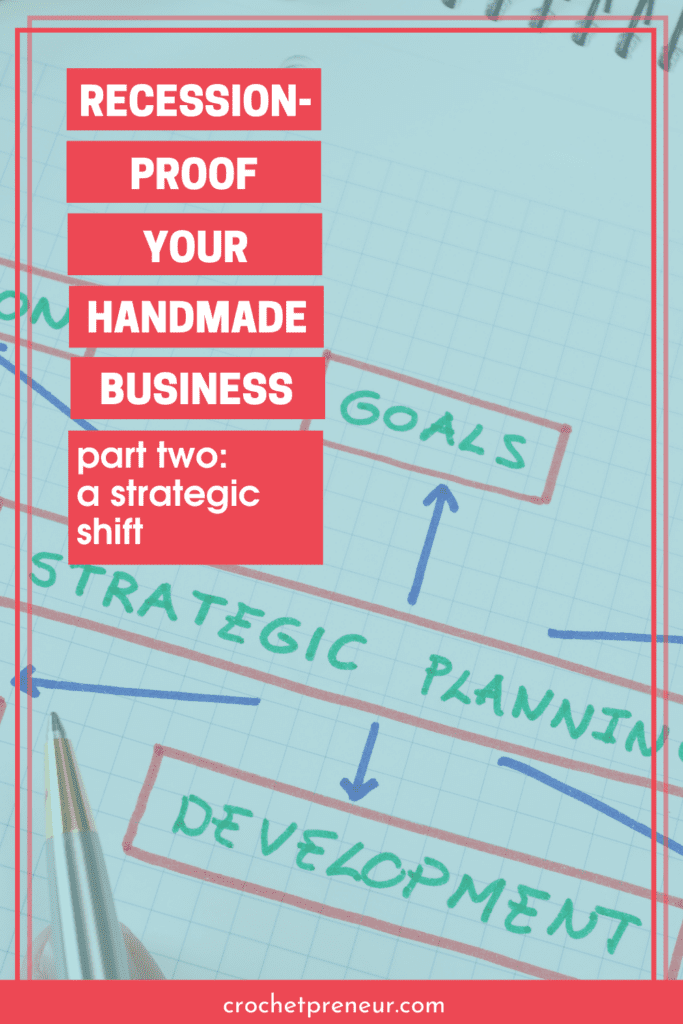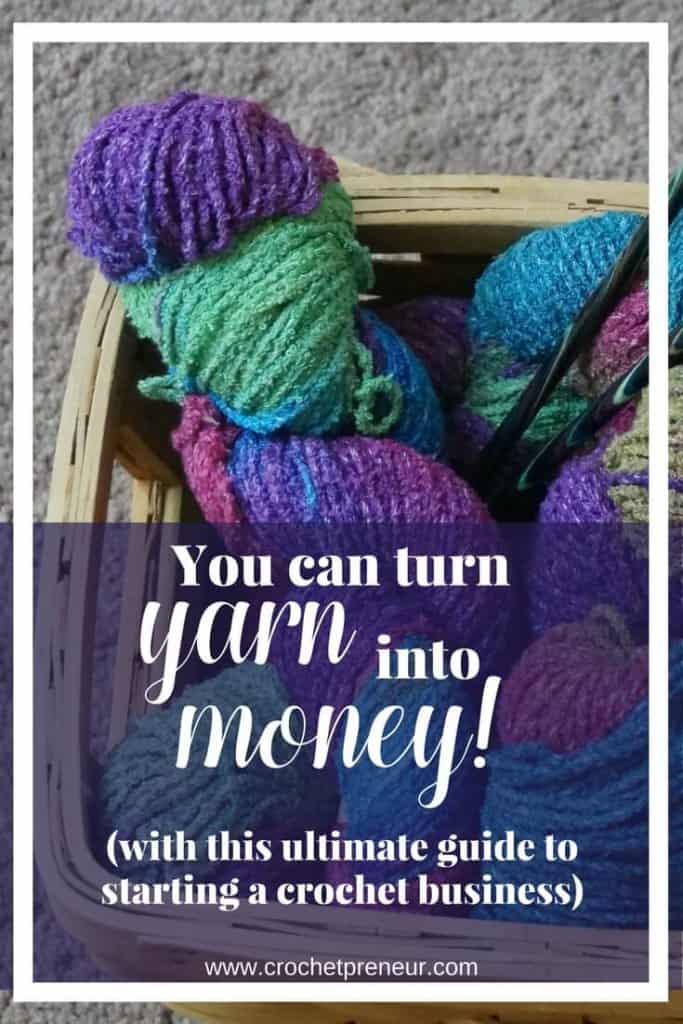With a recession on the horizon, it’s easy to slip into helplessness and powerlessness. But while you may not be able to control the economy, you can control the direction of your handmade business! You can make bold strategic moves that will give you the best chance for success. In part three of this seven-part series on Recession and Handmade Business, we will explore six areas of analysis that can help you shift your strategy and steer your handmade business with confidence in the changing marketplace.

Making Bold Moves to Prepare Your Handmade Business for a Recession
[00:00:00] Hello, hello. It’s time for Crochet Business Chat. If you have been watching our series on Recession and Handmade Business, or if you’re new here, you will definitely learn some things and get some answers from this video so I hope you hang out. We’re going to be talking about using strategy during a recession to keep your business profitable. So hang on. We’re going to be talking about six things to look at as far as strategy goes to take control of your business during economic downtime so that you can remain profitable. So hang on.
Transcript – Recession and Handmade Business #2: A Strategic Shift
[00:00:44] Welcome to Crochet Business chat. My name is Pam Grice. I am on a mission to help 100,000 women build financial freedom through crochet. And I’m so happy that you’re here. If you are a crochet business owner or you are a handmade seller, I’m happy to have you here. I hope you’ll subscribe, like this video so more people get to watch it.
[00:01:03] And let’s talk about recession. Good morning, everyone. So this is being recorded live. If you’re here live, let me know. Give me an answer, 1 to 10, one being, “I’m not worried about this at all,” to 10 being, “I’m freaked out that we might be going into a recession.” Let me know where you stand. How much have you been thinking about this? Where are you at with all of this?
[00:01:30] Good morning. Good morning, Christina. Good morning, Elizabeth. Hi, everyone. Hi, Justina. So good to see everyone. Nine, I see a seven. I see nines. Okay. So we’re freaked out about this. I want to give you some sense of control. I want to give you some hope, some positivity that with some strategic decisions, with some being bold, taking action that you can be the steerer of the ship through the course of the coming months and possibly years.
[00:02:18] I’m going to come over here and say welcome to Recession and Handmade Business. This is part two. So we talked through part one last week and I will link that in the description so that you can watch that. And today we’re going to talk about a strategic shift.
Seeing Recession as an Opportunity
[00:02:42] Successful entrepreneurs make money by leveraging opportunities. And oftentimes we see recession, or we see changes in the marketplace, not as opportunities but as stumbling blocks. And as soon as we start doing that, we give up our control. We give up our sense of empowerment. And we feel beholden to the shifts in the marketplace rather than someone who’s in control of our own destiny. And that can make us feel powerless and helpless. And that is where people tend to crash and burn because once you start freaking out to the point of you can’t make decisions, once you let that emotion take control of you, that’s when you start making bad decisions. And so we’re going to try and prevent that.
[00:03:36] So as soon as you see recession as opportunity, you can start creating a path to recession-proof profitability. And that’s my goal for you today. And we’re going to try and go through these steps as quickly as possible so you can get back to work. You know I don’t like to take too much of your time each morning. But I do want to give you some actionable things that you can do to start feeling in control.
Steering Into the Skid
[00:04:01] So I just want to talk to you a little bit about the theory of steering into the skid. If you ever took driver’s ed or your kids have taken–what’s that driving course? MasterDrive or something like that–you’ve heard about this theory of steering into the skid. Or if you live in a place where it rains or snows a lot, you’ve probably heard this theory that if you’re driving your car, your car starts to hydroplane, or you start skidding on the snow.
[00:04:30] If you’ve never experienced that before, what’s your first response? You start skidding. So your car is going straight. It starts to turn this way. What’s the first thing you do? You turn the wheel the opposite direction, right? You try and steer out of the skid. So you try and do the opposite. You try and fight against what’s happening with the car. And what happens is when you do that, the car spins out of control. You’ve totally lost control of the car when you fight the natural direction that the car is trying to go.
[00:05:05] And it’s the same thing with the marketplace. As soon as things start to turn, if you’re like, “I’m going to try and force it back this way so I can still keep doing things that I’ve always done, keep going in the direction that I think I should be going,” that’s when you start to lose control because the car’s going to do what it wants to do. The marketplace is going to do what it’s going to do. And so if you can instead steer into the skid, steer into the direction that the marketplace is going, then you get control. Then you get control of the car and you can keep it going straight. When you steer into the skid, your car will let you gain control again and then you can straighten things out.
Controlling the Direction of Your Handmade Business
[00:05:58] So I want you to keep going back to that philosophy of … As soon as you’re starting to feel things are going out of control, my immediate response is to try and force it back. But I want you to start getting creative and saying, “How can I steer into the skid so that I can be in control of the direction that I’m going?”
[00:06:25] So I’m going to give you six areas to analyze and get strategic about–six things that help you steer into what the marketplace is doing and help your business be one of the few that remains steadfast and on a direction, whether it’s the same direction you were going or a new direction. We’re going to take a look at that because what happens in a recession is that the people who steer into the skid are the people who will survive. And those who panic, who try and force something that is not going to happen, are the ones whose businesses end up failing. And we don’t want that for you.
[00:07:25] So we need to take a look at these six areas. And as you look at them, you can think about, “Do I need to modify something? How can I modify something in order to go in the flow of what’s happening and gain control again?”
Is Your Niche Recession-Proof?
[00:07:41] So the first one is your audience. Take a look at your target customer. Oh, I forgot to show you something. Let’s back up for a second. I’m going to go back to here. I’m going to go over here. Before we get started on the strategies, I want to talk about this. Now, I have to go do some research so that I can remember where I got this image from so that I can credit them down below. So I will do that. As soon as I figure out what website I grabbed this off of, I will credit that down below. In the meantime, let’s just go through this.

[00:08:34] If you’ve ever heard of Maslow’s Hierarchy of Needs, this is a theory of human need. And so first we go through the physiological needs of food, clothing, shelter, physiological, safety needs, love and belonging esteem, and self-actualization. So this is human needs. We’re going to take a look at this as how this looks at recession-proof businesses. And it’s very similar.
[00:09:02] So when we look at businesses that survive, those that are closer to the bottom are more likely to survive with ease than those up towards the top. As you start moving up this ladder, if you’re looking at your niche and you start moving up this ladder, you’re going to have to get more strategic.
Which Types of Handmade Business Do Best in a Recession?
[00:09:25] Businesses that are most recession-proof are down here, fulfilling physiological needs, comfort items, or vices. It shows here liquor and gambling. But other vices are shopping. Comfort needs are things that make me feel pretty, things that make me feel comforted, things that make me feel cozy. So this bodes well for us in our business because people are going to be looking for these things that make them feel good–that are vices for them or that simply make them feel good. And that’s what we do. So this bodes well for us.
[00:10:13] Others are healthcare, food and beverage, household staples–these are things people are going to be spending money on anyway–and baby products. Businesses in these sorts of niches tend to do well in a recession because people are going to be spending money here anyway. So consider that as you look at your niche. And maybe you don’t need to make a change. Maybe your customer base is going to be people who spend money on what you have to sell, no matter what happens with the economy.
[00:10:44] So as we move up, we’re looking at financial services, home repair, automotive, utilities, and education. That’s the next level. Move up.Weddings and life events. Fine dining, theaters, and casinos. Typically, if this relates to our business at all, it will be in the realm of party supplies, photo props, bridal items.
Least Recession-Proof Industries
[00:11:14] Then to esteem–travel and tourism, beauty, furniture, and leisure vehicles. So this would be home decor items and fashion items. However, those items could also fit down in the bottom under comfort items. So it depends on how you’re doing your messaging, how you come across. So we’re going to be talking about messaging in a little bit. Even if you feel you’re in the esteem category, if you change your messaging, now you’re down in the physiological needs category and you’re more recession proof. So keep looking at that.
[00:11:53] And then finally, we have self-actualization type businesses, which are conferences, construction, and personal services. So again, we’re going to take a look at this. And you’ll have to come back here because I don’t feel good distributing this without that attribution so I can’t send it to you. But I will get that attribution soon. So this is how we’re going to be using this to look at what we need to do in our businesses. So I’m going to come back. I’m going to come back over here.
Six Areas to Analyze in Your Handmade Business Strategy
[00:12:28] And now we’re going to take a look at six areas to analyze, to get strategic about.
Evaluate Your Target Customer
[00:12:33] So again, first your audience. Is your audience recession-resistant? Do they have the funds? Are they being strategic themselves? Are they willing to spend their money? And how are you going to speak to them? So if you typically market to people who do not have discretionary funds, who are penny pinchers, and who are being strategic with their funds right now, and are being very careful about what they buy, you’re going to really have to take a look at, “Do I still want to be marketing to these people or do I want to make a shift in my target customer base in order to be selling to people who have more discretionary funds?”
[00:13:19] So this is just a strategy you need to take a look at. It may or may not impact your business, but it’s important to ask the question and say, “Where is my audience? Are they going to still spend money on what I have or do I need to take a look at finding a new audience?”
Adjust Your Niche
[00:13:37] Next is is your niche recession-resistant? So we went and we looked at the hierarchy of recession-proof industries. Where does your business fall on that hierarchy? And how can you move your business down? Or how can you change your messaging in order to move your business down to a more stable recession-proof industry? So if you need to change your niche or if you need to add a niche.
[00:14:08] I know Christina’s here and she’s adding onto her niche. She makes lovies, which already, baby products are in that lowest level. But she’s also adding on other niches to speak to even a wider audience of homeschooling. She’s doing more of a lifestyle blog in order to try and drive more traffic to her blog so that she can get more ad revenue. Taking a look at those kinds of things of what can you do to either expand your niche or niche down to a more recession-proof niche.
Increase Your Profit Margins
[00:14:46] Next is how will you increase the margins on the offerings and the income streams that you already have? Like I said, with Christina, she has ads on her site. She’s going to be opening up her market with more and different content. She’s going to keep her target audience the same. She already speaks to this target audience. But she’s going to be sharing more of what they’re interested in on her blog
[00:15:10] Typically, I don’t recommend that. But again, times are shifting and so strategies are shifting. What used to work is going to not work any longer. And so we need to look at new things–new ways of getting in front of the people who are going to be willing to spend money with us.
[00:15:27] And so how can you increase your margins? That means looking for opportunities to lower the cost of your supplies, looking for opportunities to lower the cost of your employees or contractors, looking for ways to optimize the perceived value of your products so people see them as higher-value, you can charge more, and now you have higher profit margins. Or looking at how to make things more quickly so that you can make more products in less time. So that might mean shifting from crochet to machine knitting. That might mean moving from worsted weight products to chunky products.
[00:16:18] So there’s all sorts of things that you can do to increase your profit margins. So taking a look and brainstorming exactly what that would be for your business is a very strategic move that you can make next.
Tailor Your Marketing
[00:16:44] Number four. Does your marketing align with the times? You need to work on messaging, again, to bring your business and your messaging down to one of those lower foundational hierarchy of needs, recession-proof business, as well as understanding where your target customer is coming from–whether they’re concerned about the recession or whether they’re not concerned about it. So speaking to that, letting them know you understand.
[00:17:13] Checking in on the frequency of your marketing. Some people are saying to check in with your customers even more frequently but with shorter e-mails or shorter captions because people are stressed, and people are busy, and they’re not going to take the time to read long captions. And you know that they don’t see everything that you post. So posting more frequently will get you in front of them more often.
[00:17:41] Also, and we’ll be talking about this a little bit more in just a second, is advertising costs are cheaper. Advertising costs are plummeting right now. So once you get your messaging down, then getting Facebook ads, Google ads, YouTube ads, Pinterest ads, whatever it is, wherever your people are, looking into ads to get your messaging in front of more people because advertising costs have gone down.
Tweak Your Prices and Offerings
[00:18:10] Number five, should you raise your prices or should you change your offerings? Sometimes when you lower your price, people will see it as less valuable and they’ll be less likely to purchase. So again, this is going to be a little bit of mind reading with your target customer to say, “What will happen if I raise my prices? Will they run away or will they buy more?” It will definitely increase your profit margins. And maybe raising your prices isn’t even right for you right now. But it is important to ask the question.
[00:18:49] And do you need to change your offering? We will be talking about this in the Product Line University more–about product line and what you’re offering to your target customers as you work through the changing marketplace. But ask yourself, “Do I need to change what I’m offering in order to make it more desirable during times of recession?”
[00:19:14] So be really critical of saying, “Is my target customer going to be spending money on this right now? Or does she or he consider this a luxury that they’re not willing to pay for? Or is it a luxury that brings them peace, comfort, anxiety relief?”
[00:19:33] If you’re selling crochet patterns and your people use crochet as anxiety relief, you might find that your business is not impacted by a recession because people still need those things. Or you might find that while they still need it, they’re not willing to pay for it. So they’re looking more for free patterns. In that case, getting more free patterns will get you more traffic and will get you more ad revenue. So being really strategic about that and thinking through those things is going to be important.
Find Opportunity in Declining Prices
[00:20:04] Next is where can you find opportunity in declining prices? Like I said, finding your supplies for less money, whether that’s sales. There’s a lot of businesses right now that have overruns on inventory. And so they’re marking down prices and taking advantage of that.
[00:20:29] Also, there are a lot of people who had exited the workforce, who are now wanting to join the workforce because of inflation. Their bills are going up and they’re like, “Okay, I can’t do this anymore. I have to go get a job.” They might be willing to become a contract crocheter. They might be willing to become a virtual assistant, depending on what their skills are. But they’re going to be charging less than what has been the norm. So you can probably hire someone for much less right now than you could have in the past. So looking for that.
[00:21:00] And then again, ad costs are going down. So leveraging those opportunities to get advertising for a lower cost could really help your business. So again, look at those opportunities and decide which ones would be best for your business in order for you to grow and make yourself recession-proof.
Join Us For Product Line University!
[00:21:24] So those are the six strategies. You saw that I had talked about several different things about your audience, your niche, your offering your product line, right? And so I want to invite you to join us for Product Line University, which will be starting on July 25th. If you’re watching this on replay, it will be available for replay for years to come. But if you’re watching live or you’re watching during the week that this video is released, Product Line University is linked down below in the description [eight words back, for those reading the blog].
[00:22:00] If you’re interested in joining us, we’ll be going through five days of lessons to help you really identify and pare down your product line so that it becomes recession proof and you don’t have to worry about losing your business like so many people will in the coming months. So I really hope that you will join us for that. Right now and through July 18th, it’s on super early bird discount. So you won’t want to miss that. Go check it out. And if you’re watching after this, it is still on discount until July 29th, before it goes up to its regular price.
[00:22:36] So go ahead and click there. Register for Product Line University so you can deep dive into really honing in on your perfect, profitable, recession-proof product line.
Community Discussion
[00:22:36] I’m so happy to have you all here. Let me go check out–see if you have any questions or comments before I let you go about your day. “Excited about a new direction.” Yes, Christina’s going to be rocking it.
When Customers Struggle With Money
“This is one of my worries. My audience is disabled crocheters and knitters. Money was bad before the threat of recession.” So you are going to have to figure out ways to maybe make money from other sources than your customers.
[00:23:18] So that could be ad revenue. That could be affiliate sales where other people might have things that your target audience is willing to pay money for, even if they’re not willing to pay for your products. So say If there’s a book that they would be willing to spend money on, then get an affiliate link for that and share that with them. If there is an ergonomic crochet hook, maybe that would be really helpful for them. Get the affiliate link for that and share that with them so that you can be making money from affiliate sales, even if you’re not making money from your own pattern sales.
[00:23:57] Or again, starting a blog, getting on an ad network and providing them free content and letting them know, “How do I make money? It’s by you coming to my blog. It’s you spending money on my blog or spending time on my blog. It’s you clicking through to products that are advertised on my blog or clicking through my affiliate links.” And let them know that and let them support you. It could even be creating a Patreon channel. It could be creating a buy me a coffee link or something like that, even.
Using Copyrighted or Trademarked Logos: Be Careful!
[00:24:33] “I make boy band logo sweater. But to expand, I’m making bags and maybe fingerless gloves from leftover yarn.” Be careful about boy bands’ logos if you don’t have a license for those. They could come after you. Copyright infringement or trademark infringement fines are very steep–$150,000 per infringement. And that means if you’ve sold three sweaters with someone else’s logo on them, that comes up to a lot of money. So $450,000 for three sweaters. Be careful and check into that. If you need to go get a license and you’re willing to pay for that, get a license. Otherwise I would suggest checking your niche and finding something that’s not copyright-infringing.
How Community Members Are Strategizing
[00:23:39] “I’ve been focusing on affiliate sales–” perfect– “as well as getting patterns published in magazines.” Excellent. So magazines will pay you, which is great. “And YouTube with affiliate links and YouTube Adsense.” Perfect, Sarah. Chanel says, “I’m really excited for Product Line University. I’m going to pivot and focus more on my blog so I can get in with an ad network.” Yay! “Plus, I want to see if I can get my Ribblr shop off the ground and see if I can make new royalties thing there work.” Okay, great. So if you haven’t heard about Ribblr, if someone uses your pattern on Ribblr and they’re selling the physical product on Ribblr, if they sell a product using your pattern, you get a commission, which is a really nice little benefit. So that’s really cool.
More Handmade Business Resources
[00:26:13] I hope that you found this helpful. We’re going to link here and here, two other videos. One is How to Start a Crochet business, Even When You Don’t Have A Lot Of Money. And then the other is the playlist for this entire series. So if this is your first time coming to the series, you can click on the playlist and start over from the beginning and catch all of the videos. There will be seven total. This is our third one. We had the introduction, part one, and this is part two. I hope you will enjoy that.
Let’s Connect on Social Media
[00:26:46] Please share this with your friends. I’m trying to grow my YouTube channel. I’m trying to reach as many people as possible. You know we’re on a mission to help 100,000 women. We’re at 35,589. We can’t grow without your help. So if you would share this either on your Facebook page or as a story on Instagram, we’d be eternally grateful, as well as be sure to subscribe so that you can be notified when we come live next Monday with part three. And click the notification bell so you’re notified. And like this so more people see it. And do all the things. Just do all of the things. I would really appreciate it.
Wrapping Up
[00:27:28] Okay. Perfect. Thank you, everyone. I hope you have a wonderful week, a profitable week, a productive week, and also a week that feels really life-giving and uplifting to you. All right. I will talk to you guys later. See you next week.










